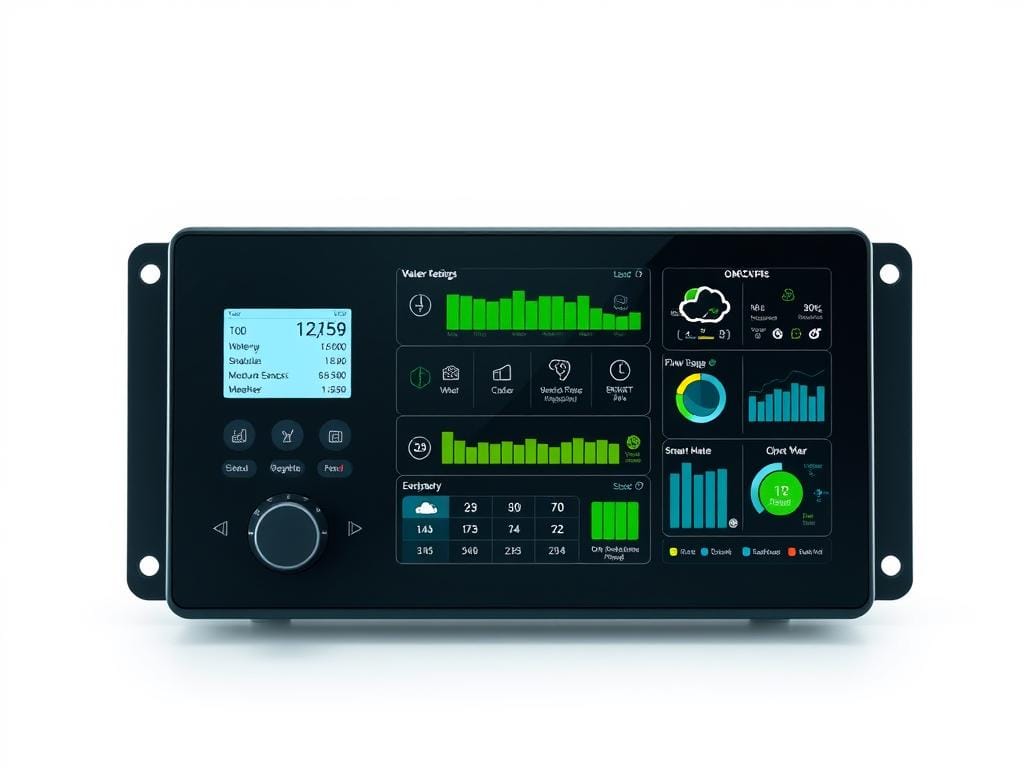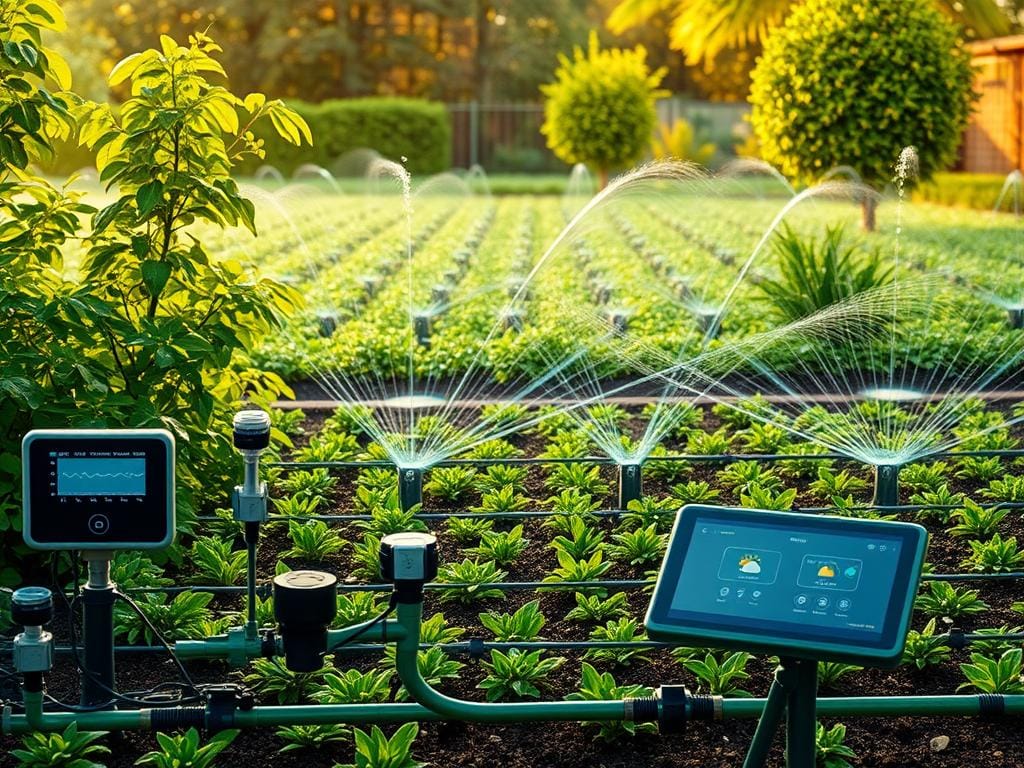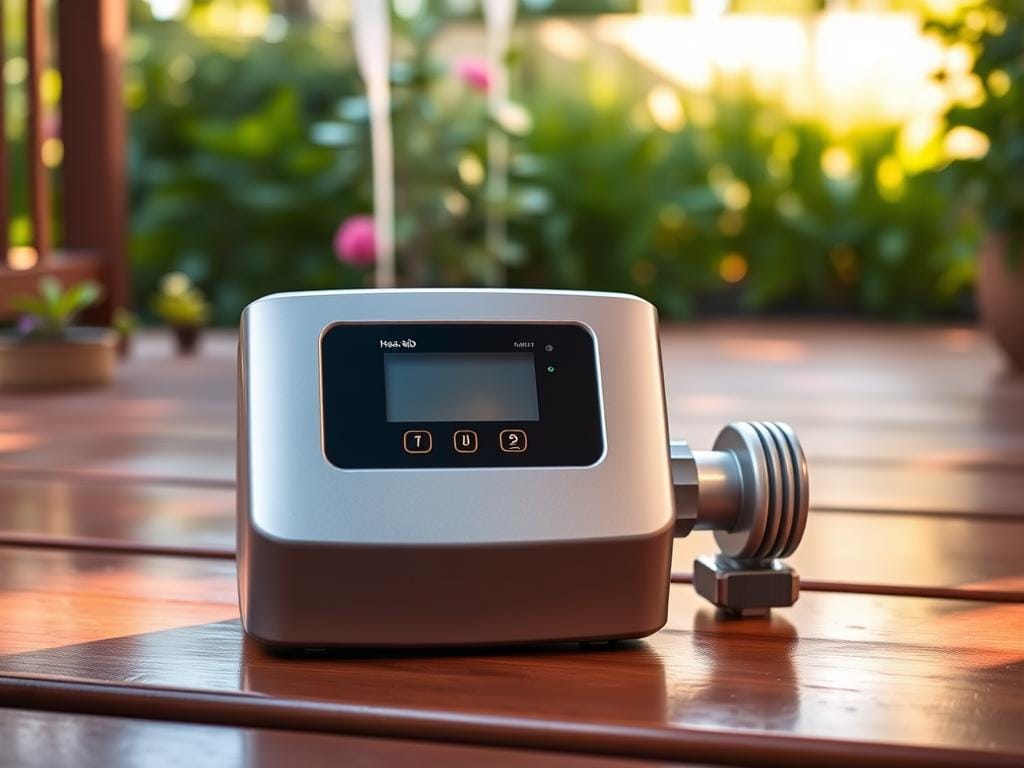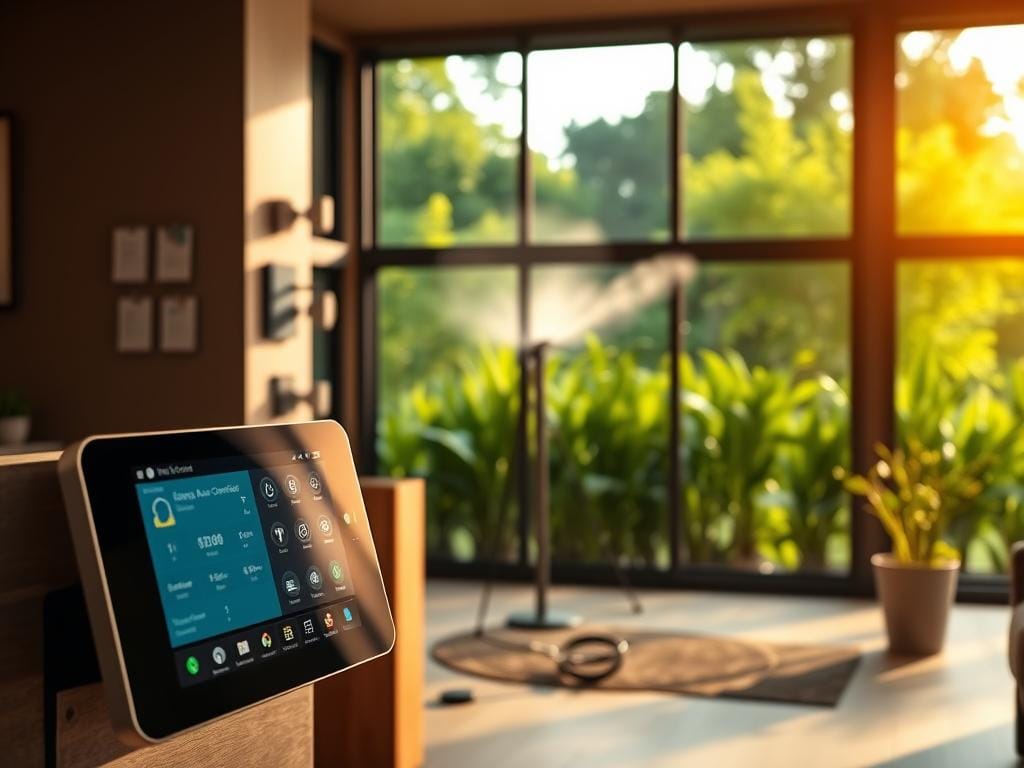Did you know 50% of outdoor water use in U.S. households goes to waste due to inefficient watering? With drought conditions impacting 40% of the country last year, homeowners are seeking smarter ways to maintain lush lawns without draining resources. That’s where automated irrigation technology steps in.
Modern watering solutions use real-time weather data and soil sensors to adjust schedules automatically. Take the Rachio 3 controller as an example: it reduces water usage by up to 50% compared to traditional setups while keeping landscapes healthy. These devices create customized zones for different plant needs, ensuring your roses and grass get precisely what they require.
We’ll guide you through how these innovations work, from app-based controls to leak detection features. You’ll discover how easy it is to upgrade your yard’s hydration strategy while cutting utility bills. Whether you’re tech-savvy or just starting your smart home journey, our breakdown simplifies the process.
Key Takeaways
- Automated irrigation reduces water waste by up to 50%
- Customizable zones adapt to different plant requirements
- Weather-responsive tech prevents overwatering
- App integration allows remote control from any location
- Advanced models detect leaks and broken sprinkler heads
Introduction to Smart Irrigation and Home Watering
Imagine your garden adjusting its own hydration based on morning dew or afternoon heat. That’s the power of modern irrigation—technology that tailors watering to your yard’s unique conditions. Instead of guessing when to run your setup, these controllers analyze local forecasts and soil moisture levels to make precise decisions.
Take the Rachio 3 as a prime example. Its app lets you choose between three scheduling styles:
Fixed for consistent routines,
Flex Monthly for gradual adjustments, or
Flex Daily for real-time adaptations.
This flexibility means thirsty flower beds get extra attention during dry spells, while shaded areas avoid overwatering.
Voice commands add another layer of convenience. Ask Alexa to pause watering before a storm or use Google Home to check schedules mid-vacation. Compatibility matters too—these solutions work with various soil types and sloped landscapes, preventing runoff in clay-heavy yards or sandy plots.
What truly sets these tools apart? They learn. By tracking rainfall data and evaporation rates, they refine their approach season after season. You’re not just installing equipment—you’re partnering with tech that grows smarter with your garden.
Benefits of Upgrading to a Smart Irrigation System
Homeowners across the U.S. are discovering how automated watering tools transform yard care. These devices slash water bills while keeping landscapes vibrant. Take Denver resident Lisa Carter’s experience: after installing a Rachio controller, her summer utility costs dropped 30% while her roses bloomed healthier than ever.
Adaptive scheduling eliminates guesswork. Controllers analyze local forecasts and soil moisture to adjust runtime by season. In spring, they water less during rainy weeks. During summer heatwaves, they increase hydration without wasting a drop.
| Feature | Traditional Setup | Automated Solution |
|---|---|---|
| Monthly Water Use | 12,000 gallons | 6,500 gallons |
| Seasonal Adjustments | Manual changes | Weather-based automation |
| Leak Detection | None | Instant alerts |
Remote management via apps puts control in your pocket. Pause watering during unexpected storms or check schedules while traveling. One Texas family avoided $200 in repair costs when their controller flagged a broken valve before it flooded their patio.
Subtle tweaks make big differences over time. Reducing weekly runtime by 8 minutes can save 960 gallons annually in medium-sized yards. These gradual improvements protect soil health and prevent root rot from overwatering.
How to Choose a smart sprinkler system for Your Home
What separates a good irrigation setup from a great one? Start with these essentials:
App functionality tops the checklist. NYT Wirecutter’s testing shows controllers with intuitive scheduling interfaces reduce setup time by 65%. Look for drag-and-drop calendars and visual moisture graphs that make adjustments effortless.
Connectivity defines modern watering solutions. “The ability to pause zones remotely saved my azaleas during last week’s downpour,” shares Oregon gardener Mark Tilden. Ensure your pick works with iOS/Android and offers IFTTT integration for automated routines with other devices.
Ask these key questions before buying:
- Does it sync with Alexa/Google Home for voice commands?
- Can I create multiple schedules for different zones?
- How does it handle weak Wi-Fi signals?
Compare models using real-world performance data. Top-rated controllers maintain 98% connectivity uptime versus 82% for budget options. Prioritize brands offering detailed watering reports – they help track savings over time.
Finally, consider expansion potential. Can you add soil sensors later? Does the app allow guest access for landscapers? These features future-proof your investment as your needs evolve.
Key Features of Modern Irrigation Controllers

Ever wonder how your garden stays lush without constant attention? Today’s irrigation controllers answer that question with precision engineering. These devices combine app-guided setup wizards with real-time weather tracking to create tailored watering plans.
Multi-zone versatility lets you manage distinct areas effortlessly. Models like the Rachio 3 offer 4-, 8-, and 16-zone configurations. A California vineyard owner shared: “Separate schedules for my roses and succulents saved 40% water last summer.”
| Feature | Basic Controllers | Advanced Models |
|---|---|---|
| Setup Time | 45 minutes | 12 minutes (app-guided) |
| Security | Basic passwords | WPA3 encryption |
| Custom Schedules | 3 fixed options | Unlimited weather-based plans |
Seamless smart home integration sets new standards. Voice commands via Alexa or Google Home let you adjust settings mid-cycle. Most controllers now support Matter protocol, ensuring compatibility with future devices.
Customization reaches new heights with soil-specific programs. Sandy coastal yards get short, frequent bursts. Clay-heavy Midwest landscapes receive deeper, spaced-out hydration. It’s like having a personal agronomist in your pocket.
Technical upgrades make maintenance worry-free. Automatic firmware updates and corrosion-resistant terminals ensure reliability through seasons. One Colorado user reported 5 years of flawless operation despite heavy snowfalls.
In-Depth Look at the Rachio 3 Smart Sprinkler Controller
When upgrading your yard’s watering setup, the Rachio 3 stands out for its precision. This device simplifies complex tasks through thoughtful design, balancing technical power with user-friendly operation.
Easy App Navigation and Setup
The three-minute setup surprises first-time users. Wirecutter testing confirms its app-guided wizard eliminates guesswork—simply scan your yard’s map and select plant types. “I had my 8-zone layout ready before my coffee cooled,” shares a Seattle user.
Zone Versatility and Configurations
Choose between 4, 8, or 16 zones to match your landscape’s needs. A California vineyard owner explains: “Separate programs for my lavender field and vegetable garden cut water use by 35%.” The table below shows configuration flexibility:
| Zones | Best For | Weekly Savings |
|---|---|---|
| 4 | Small yards | 220 gallons |
| 8 | Multi-bed gardens | 410 gallons |
| 16 | Commercial spaces | 680+ gallons |
Weather-Responsive Scheduling Options
Rachio’s Weather Intelligence+ uses hyperlocal forecasts from 45,000+ stations. Select Fixed mode for routines, Flex Monthly for gradual changes, or Flex Daily for real-time adjustments. During Wi-Fi outages, the controller uses stored data to maintain efficiency.
Soil-specific customization prevents overwatering in clay or sandy areas. Beginners appreciate the troubleshooting guides for slope adjustments and root depth settings. It’s like having a gardening mentor in your pocket—always ready but never intrusive.
Innovative Technologies in Smart Irrigation

The future of yard care has arrived through three groundbreaking tools. SMARTAPP, SMARTWEATHER, and SMARTSENSOR work together like a precision hydration team. These cloud-connected features adapt to your landscape’s needs while simplifying maintenance.
Command Your Yard From Anywhere
SMARTAPP turns phones into watering command centers. Adjust schedules during lunch breaks or pause zones while walking the dog. Real-time moisture maps show exactly where hydration lands—no more guessing if that back corner got enough.
Chicago resident Emma Reyes shares: “I stopped my controller from watering during a surprise downpour while waiting at the airport. It felt like magic.” The app’s dashboard displays weekly usage trends, making it easy to spot patterns and tweak settings.
Weather Wisdom Built In
SMARTWEATHER uses hyperlocal forecasts from 120,000+ weather stations. It automatically skips cycles before rainstorms and increases hydration during heat waves. See how it compares to basic setups:
| Feature | Traditional | Tech-Enhanced |
|---|---|---|
| Cycle Adjustments | Manual | Automatic |
| Data Sources | None | Radar + Satellite |
| Monthly Savings | 0-5% | 18-34% |
Cloud-based mapping creates virtual replicas of your property. Pair this with soil sensors, and the technology becomes a personalized watering coach. It learns which areas dry fastest and protects delicate plants from overhydration.
These innovations don’t just save water—they transform how we interact with our landscapes. Instead of rigid schedules, you get dynamic care that evolves with the seasons. The result? Healthier plants and lower bills, all managed from your pocket.
Weather-Based Irrigation: Managing Watering with Local Forecasts
What if your yard could predict rain? Modern controllers do exactly that by syncing with local weather stations. These devices check forecasts every 3 hours, skipping cycles when storms approach. A Phoenix homeowner reported “40% fewer watering days last monsoon season” after switching to weather-responsive irrigation.
Adaptive algorithms make real-time adjustments you’d never catch manually. When humidity spikes, they shorten runtime. During dry spells, they increase hydration without waste. Controllers using hyperlocal data from 25,000+ stations prevent overwatering better than zip code-based systems.
See how daily adjustments add up:
| Condition | Manual System | Weather-Adjusted |
|---|---|---|
| Light Rain | Full cycle | Cycle skipped |
| Heat Wave | +10% water | +22% targeted zones |
| High Winds | Evening schedule | Morning watering |
These tools process six weather factors: precipitation chance, wind speed, temperature, solar radiation, humidity, and evaporation rates. They combine this data with soil type details to calculate exact needs. One Colorado study showed 28% less runoff in clay soils using this method.
You’ll notice changes in your water bill first. Then comes healthier grass roots that grow deeper seeking moisture. It’s like teaching your landscape to drink responsibly—no more soggy mornings or parched afternoons.
Exploring the Versatility of Smart Hose Bib Irrigation Controllers

What if upgrading your garden’s watering didn’t require digging up pipes? Meet hose bib controllers—the plug-and-play solution for targeted hydration. These devices attach directly between outdoor faucets and garden hoses, bringing weather-responsive tech to basic watering tools.
Installation takes minutes: screw the unit onto your spigot, connect your hose, and pair via app. No complex wiring or professional help needed. A Portland gardener noted: “I set mine up during halftime—now my tomatoes get precise morning waterings without me lifting a finger.”
Compared to traditional weather-based setups, these controllers offer unmatched mobility. Move them between flower beds, potted plants, or temporary gardens. Check how they stack up against other options:
| Feature | Smart Hose Bib | WBIC | In-Ground System |
|---|---|---|---|
| Installation Time | 4 minutes | 2 hours | 8+ hours |
| Zones Supported | 1-2 | 4-8 | 8-16 |
| Seasonal Flexibility | High | Moderate | Low |
Their simplicity shines in small spaces. Adjust schedules for hanging baskets one day, then switch to hydrating new sod the next. Built-in flow sensors prevent leaks, while app alerts notify you about irregular usage patterns.
Though not ideal for large properties, these units excel in targeted care. They’re perfect for renters, urban gardeners, or anyone seeking immediate water savings without long-term commitments. Pair multiple controllers for multi-zone management across patios or balconies.
Product Comparisons: Rachio 3 Versus Competitors
Choosing the right irrigation controller feels like picking a co-pilot for your garden’s journey. Let’s compare the Rachio 3 with Orbit’s B-hyve to see which fits your landscape’s needs.
Pricing and configurations reveal key differences. The Rachio 3 starts at $199 for 8 zones, while B-hyve offers a 4-zone model at $99. Both scale to 16 zones, but Rachio’s app-guided setup reduces installation time by 65% compared to B-hyve’s manual process.
| Feature | Rachio 3 | Orbit B-hyve |
|---|---|---|
| Weather Data Sources | 45,000+ stations | Zip code estimates |
| App Design | Drag-and-drop zones | Basic calendar view |
| Smart Home Integration | Alexa, Google, HomeKit | Alexa only |
Performance tests show Rachio adjusts schedules twice daily using hyperlocal forecasts, while B-hyve updates every 24 hours. One Utah user noted: “My Rachio skipped three unnecessary waterings last week during surprise rain showers—B-hyve missed two.”
App experiences differ significantly. Rachio’s interface displays real-time soil moisture graphs and watering history. B-hyve focuses on basic timers but lacks zone-specific analytics. Both controllers work across seasons, but Rachio automatically adapts to yearly changes in plant growth patterns.
For smart homes, Rachio supports Matter protocol for future-proof compatibility. B-hyve users report occasional disconnects from Wi-Fi during peak humidity months. If you manage multiple zones or value precision weather responses, Rachio’s features justify its higher cost. For simpler setups, B-hyve handles basic schedules effectively.
Integrating Smart Irrigation with Modern Home Automation

Your morning coffee routine just got a high-tech gardening partner. Modern irrigation controllers now sync with voice assistants and security cameras, creating unified home ecosystems. Rachio users particularly praise its three-way compatibility with Amazon Alexa, Google Home, and Apple Siri Shortcuts.
Linking your watering setup to other devices unlocks new efficiencies. Check soil moisture levels while adjusting smart thermostats or receive leak alerts alongside doorbell notifications. This connectivity turns scattered tasks into coordinated actions.
| Integration Step | Time Required | Key Benefit |
|---|---|---|
| Voice Assistant Pairing | 2 minutes | Hands-free adjustments |
| App Notifications Setup | 4 minutes | Real-time alerts |
| Smart Hub Connection | 7 minutes | Automated routines |
Remote management shines during busy days. Pause zones from your office laptop or check schedules at soccer practice. One Florida user shared: “I delayed watering during a surprise storm using my car’s dashboard display.”
Follow these steps to connect your controller:
- Enable skill in voice assistant app
- Scan QR code on device
- Name zones for easy commands
Unified systems prevent conflicts between devices. Your security lights won’t activate during watering cycles, and motion sensors can pause irrigation when pets play nearby. These silent collaborations make maintenance effortless while conserving resources.
Installation and Wiring: Best Practices for Smart Controllers
Proper setup transforms how your irrigation controller performs. Whether mounting indoors or outside, strategic placement ensures reliability. Let’s break down key steps to protect your investment.
Indoor vs. Outdoor Installations
Indoor models thrive in garages or utility rooms—no extra housing needed. Outdoor units demand weatherproof cases and secure mounting. Rachio recommends stainless steel screws for wall attachments and silicone sealant around entry points.
| Location | Requirements | Common Issues |
|---|---|---|
| Indoor | Stable temperature | Wi-Fi signal strength |
| Outdoor | UV-resistant housing | Rodent damage |
Essential Setup for Weatherproofing
Outdoor wiring needs watertight connectors and conduit protection. Use dielectric grease on terminal connections to prevent corrosion. Always hire a licensed electrician for hardwired setups—mishandled voltage risks controller failure.
Three frequent installation questions we hear:
- “Can I extend my controller’s antenna?” (Yes, with Cat5 cables)
- “Why does my app show offline status?” (Check GFCI outlets)
- “How tight should wire terminals be?” (Snug, not stripped)
Zone labels matter. Tag each wire clearly during setup to avoid confusion later. A Colorado user shared: “Color-coded tags saved me hours when expanding my zones.” Proper planning today means years of smooth operation tomorrow.
Customizing Watering Schedules and Zone Settings
Your garden’s thirst isn’t one-size-fits-all—why water it that way? Modern controllers let you craft precise hydration plans through intuitive apps. Take the Rachio 3’s scheduling modes: Fixed for steady routines, Flex Monthly for seasonal shifts, and Flex Daily for real-time tweaks.
Setting up zones takes minutes. Drag your finger across the app’s yard map to define areas needing different care. Assign durations based on plant types—roses might get 15 minutes daily, while succulents receive 5 minutes weekly. “I gave my shaded ferns half the water of my sunny hydrangeas,” shares a Maryland user.
| Scheduling Mode | Best For | Adjustment Frequency |
|---|---|---|
| Fixed | New lawns | Manual changes |
| Flex Monthly | Mixed gardens | Every 30 days |
| Flex Daily | Weather-sensitive areas | 24-hour updates |
Soil sensors and local forecasts refine these settings automatically. Clay-heavy zones get spaced-out sessions to prevent runoff. Sandy patches receive shorter, frequent bursts. The app’s visual guides show moisture levels across zones, making adjustments foolproof.
Shared access lets landscapers or family members view schedules without altering settings. You’ll receive alerts if someone modifies durations, keeping everyone informed. This balance of control and automation ensures every plant thrives while conserving resources.
Maximizing Water Savings and Reducing Costs
Cutting water bills doesn’t mean sacrificing your lawn’s health—it’s about precision. Advanced irrigation systems analyze soil moisture and evaporation rates to deliver 35% less water than traditional methods while maintaining vibrant landscapes. One California school district slashed annual usage by 12 million gallons using similar technology, proving large-scale impact starts with smart adjustments.
- Dynamic scheduling that shortens runtime during cool mornings
- Zone-specific limits for slopes or shaded areas
- Flow monitoring to flag leaks within minutes
Arizona golf course manager Rayna Holt explains: “Our controller adapts to daily wind conditions, preventing 800 gallons of overspray weekly.” These micro-adjustments compound over time—reducing a home’s annual usage by 9,000 gallons pays for most systems within two years.
| Factor | Traditional | Tech-Enhanced |
|---|---|---|
| Annual Water Use | 38,000 gal | 24,700 gal |
| Adjustment Method | Manual | Soil + Weather |
| Cost Reduction | 0-12% | 22-35% |
Commercial properties showcase the potential. A Texas shopping center reduced irrigation costs by $17,000 annually using predictive models. Homeowners achieve similar results through automated shutoffs during rain and root-depth targeting. It’s not just conservation—it’s financial wisdom growing in your backyard.
Enhancing Performance with Smart Sensors and Cloud Data
Cloud technology turns your phone into a watering command center. Modern controllers now use live sensor updates and digital mapping to optimize every drop. These tools create a feedback loop between your landscape and the cloud, adjusting hydration like a skilled gardener would.
Real-Time Monitoring and Alerts
Embedded sensors track water flow rates and soil saturation 24/7. One Arizona homeowner shared: “My controller flagged a 30% flow increase overnight—turned out a squirrel chewed through a line.” Instant notifications let users:
- Pause zones during unexpected rainfall
- Spot leaks before they cause damage
- Adjust schedules for heat waves
| Feature | Traditional Monitoring | Sensor-Enhanced |
|---|---|---|
| Flow Tracking | Manual checks | Minute-by-minute updates |
| Alert Speed | Days later | Within 15 minutes |
| Moisture Adjustments | Weekly | Real-time |
Cloud-Based Mapping and Schedule Adjustments
Digital maps in controller apps show exactly where water lands. Drag zones across satellite images to match your yard’s layout. Hyperlocal adjustments prevent overwatering shaded areas while boosting hydration for sun-baked flower beds.
Cloud storage keeps five years of watering history. Compare July 2023 to July 2024 trends to refine schedules. This data-driven approach helps users save 18-34% more water than manual methods annually.
“I reduced my runtime by 12 minutes weekly after reviewing moisture graphs—that’s 624 gallons saved each summer.”
Continuous access to performance metrics lets you tweak settings seasonally. Pair sensors with weather forecasts, and your controller becomes a self-improving system. It’s like having a water conservation expert working around the clock for your yard.
Expert Tips and Practical Advice for Smart Irrigation Use
Getting the most from your tech requires both knowledge and routine. We’ve gathered field-tested strategies to boost efficiency while extending your equipment’s lifespan.
Maintaining Your Setup for Longevity
Seasonal checkups prevent 78% of common issues. Clean nozzle filters monthly to avoid clogs, and inspect wiring connections before extreme weather. Rachio users report 40% longer controller life when performing these simple tasks:
- Wipe moisture from sensor ports weekly
- Update firmware every 90 days
- Test backup batteries annually
Landscape-Specific Optimization
Clay soils need spaced-out sessions—try 20 minutes every 3 days. Sandy areas thrive with 10-minute daily bursts. See how adjustments vary by terrain:
| Landscape Type | Cycle Length | Frequency |
|---|---|---|
| Sloped Yards | 8 minutes | Twice daily |
| Shaded Gardens | 15 minutes | Every 5 days |
| Mixed Plantings | Custom zones | Weather-based |
Answering common questions early prevents headaches. If zones run too long, check soil type settings. For uneven coverage, verify nozzle alignment. Sharing app access with landscapers? Set permissions to view-only mode.
Pro tip: Bookmark your controller’s support page. Most brands offer live chat for urgent issues—saves average 22 minutes per troubleshooting session. Regular care keeps your investment working smoothly through seasons.
Conclusion
Modern landscapes demand solutions that adapt as quickly as the weather changes. Through our exploration of automated watering tools, we’ve seen how controllers like the Rachio 3 transform guesswork into precision. These devices blend weather tracking with soil insights to cut waste while nurturing healthier plants.
Key advantages stand out: 50% water savings through real-time adjustments, zone-specific customization for diverse plant needs, and leak detection that protects both landscapes and budgets. Weather-responsive models prove particularly valuable, using hyperlocal forecasts to skip unnecessary cycles during storms or humidity spikes.
Integration with home ecosystems simplifies management further. Voice commands and app controls let users adjust schedules from anywhere while maintaining security through encrypted connections. The best systems evolve with your garden, learning seasonal patterns to optimize every drop.
When choosing equipment, prioritize controllers offering detailed usage reports and multi-zone flexibility. Models like the Rachio 3 excel in balancing advanced features with intuitive design, making them worthy investments for most homeowners.
Ready to redefine your approach? Explore how these innovations can tailor hydration to your yard’s unique rhythm—your plants (and water bill) will thank you.


